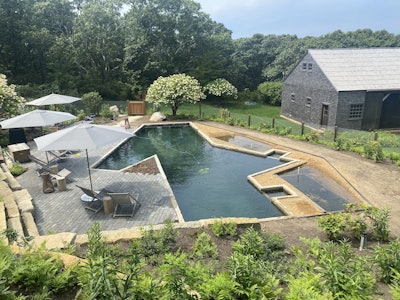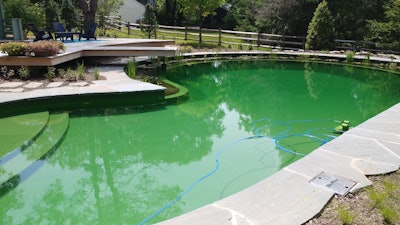
Natural swimming pools and ponds continue to grow in popularity in North America due to the unique characteristics that separate them from traditional pools. As consumers and the trade have become more familiar with the concepts and techniques that are used in building NSPs, several fictions have cropped up in articles on the topic, and these are sometimes forwarded on in discussion by those still learning about these natural vessels.
In particular, it's important to dispel three common myths about natural swimming pools or natural swimming ponds (collectively NSPs) that pop up from time to time in columns and commentary that hinder a true understanding of the product.
1. They Can Be DIY Construction
This myth has just the right amount of truthiness to be compelling because somehow the realization that these pools are “natural” makes it seem that they should be easier to build than a traditional chemical pool. People think that they can just watch a YouTube video and then know how to build an NSP.
That’s about as true as thinking that you can just watch a YouTube video and then know how to build a traditional chemical (inground) pool. An overarching point that is always missed in the NSP DIY story is that the pool was built with a building permit and in compliance with swimming pool codes.
If we are constructing a vessel, at least in the U.S., with the intent of having people swim in it, it’s imperative that it be permitted and constructed in conformance with applicable swimming pool codes. Depth configurations, access/egress design, VGB compliance, electrical safety, diving envelopes, etc., should be adhered to. Failure to do so opens up the homeowner and the contractor to serious liability should someone be injured or killed in the pool.
In other countries it is not always the case that an NSP has to be constructed in conformance with swimming pool codes, but here in the U.S., it is a cornerstone of the NSP industry and required by all members of the U.S.-based Association for Swimming Ponds and Natural Swimming Pools.
I have been building traditional chemical pools for over 50 years (since I was a teenager and working for my Dad) and have been designing and building NSPs since 2008, and I know from firsthand experience that building an NSP is way more difficult than building a traditional chemical pool. In general, we don’t recommend DIY for a chemical pool and to recommend DIY for an NSP is even sillier.

2. An NSP is Cheaper to Build
That's just ridiculous. If the goal is to build a pool as cheaply as possible, a chemical pool will always be easier and cheaper to build. NSPs are more complex. They require ALL of the structural components of a chemical pool — no matter what technology of construction you use — AND they require a biological filter.
3. An NSP Requires Less Maintenance
This is also not true. An NSP requires all of the same physical maintenance as a chemical pool — the skimmer baskets need to be cleaned; the pump basket needs to be cleaned; the pool needs to be vacuumed, and the filter needs to be cleaned and sometimes backwashed.
If you choose not to vacuum the pool, it will get dirty, and if you choose not to clean the filter, it will eventually clog and jam and not work anymore.
The only aspect of requiring less maintenance that is true, is the chemistry — no chemicals are used at all. We don’t shock the pool. We don’t add algaecide, and we don’t adjust the pH, etc.
The whole point of an NSP is that it is a nature-based solution for clarifying and purifying swimming pool water. It is a sustainable technology with an extremely low carbon footprint and can actually be a carbon sink with net zero energy consumption.
In spite of these debunked myths, there is still much to love about an NSP. Clear, soothing, non-irritating, naturally purified, water. An environmentally sustainable nature-based solution for your swimming pleasure. And for those wanting a “Walden pond-like” aquatic sanctuary, an NSP with a planted regeneration zone provides so much more than just biologically treated water. The colors, textures and diversity of the flora and fauna in this aquatic oasis will foster a whole new dimension to an outdoor living space.
James Robyn is the President and CEO of BioNova Natural Pools, a company based in Chester, N.J. that provides design, planning and dealer support for the construction of NSPs in North America. He is also an owner of Rin Robyn Pools, a builder of traditional, chemical pools as well as NSPs, and a member of the faculty of Genesis.











































